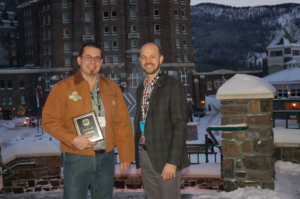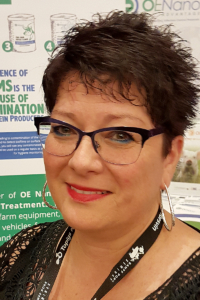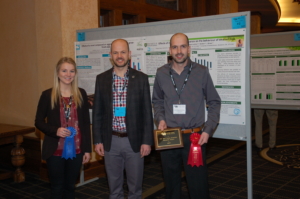F.X. AHERNE PRIZE FOR INNOVATIVE PORK PRODUCTION
The very real threat that livestock haulers can also carry disease has created ongoing efforts to ensure that tractors and trailers are thoroughly cleared of manure and other organic material between loads.
Among those at the leading edge of improving safety for pigs and producers is Manitoba-based Steve’s Livestock Transport, whose subsidiary, Blue Water Wash, operates truck and trailer washes in Red Deer, Alta., Blumenort, Man. and Brandon, Man.
 Ever mindful of how difficult it is to effectively cleaning the undersides and wheel wells of truck trailers, Blue Water Wash has developed and installed an undercarriage washing system at its Blumenort site.
Ever mindful of how difficult it is to effectively cleaning the undersides and wheel wells of truck trailers, Blue Water Wash has developed and installed an undercarriage washing system at its Blumenort site.
Its system utilizes a series of rotating pressure heads mounted in the floor. The heads each contain a set of nozzles that spray water into every nook and cranny in the trailer’s undercarriage at 580 pounds per square inch (four million Pascal). The undercarriage wash takes a little more than two minutes.
On Jan. 11, Day 1 of the Banff Pork Seminar, Bill Rempel from the firm’s Red Deer site accepted the annual F.X. Aherne Prize, which set up to recognize innovations that improve safety and efficiency in pork facilities.
The award was created and developed in memory of the late Frank Aherne, a researcher and professor in swine nutrition at the University of Alberta and co-founder of the Banff Pork Seminar.
Rempel said he and his co-workers at Blue Water Wash have identified some improvements that could be made in the design of their undercarriage washing and disinfecting system. Those changes will be included in new systems to be installed at the Red Deer and Brandon sites.
He said he has seen mixed results from a new type of disinfectant that was on display in the Banff Pork Seminar’s trade floor. However, he qualified his findings by stating that Blue Water Wash has not used the full line of products recommended in its system, including a spray that will show any build-up of biofilm.
Laura Iorio, a sales agent for OE Nano Advantage, said a non-toxic disinfectant based on Nano technology was developed by a research team from Edmonton for biosecurity and infection control of facilities in the protein industry. It is most effective when used in a five-step process that includes initial cleaning through follow-up with a “finder” after disinfection. The finder works in a similar fashion to a product called Luminol, which is employed by forensic technicians looking for traces of human blood.
“We have an ultra-enzymatic cleaner . . . that utilizes enzymes, so that it digests the proteins,” said Iorio. The surfaces  are then sprayed with chlorhexidine, commonly used to prepare skin for surgery, to disinfect surfaces. The chlorhexidine is formulated to remain on the surface after it dries, providing continual protection against bacterial growth, said Iorio.
are then sprayed with chlorhexidine, commonly used to prepare skin for surgery, to disinfect surfaces. The chlorhexidine is formulated to remain on the surface after it dries, providing continual protection against bacterial growth, said Iorio.
OE Nano developed its technology and processes as an alternative to harsh chemicals that are potentially harmful to workers and the environment, she said. “You get into confined spaces and you’ve got all these various chemicals interacting with each other, it’s not good for the workers, it’s not good for the animals, and the by-product of using all of that is it’s going into the soil and it just keeps perpetuating through nature.”
OE Nano’s line of products biodegrade in the septic system and will not leave harmful residues, said Iorio. “We’re going to save you a ton of money, because you’re not going to use as much.”
Additionally, barn managers and truck washes following the system as recommended can feel assured that their surfaces are properly cleaned and disinfected, she said.
R.O. BALL YOUNG SCIENTIST AWARD
The R.O. Ball award, re-named in honour of a recently-retired nutritionist from the University of Alberta, was set up to encourage and reward graduate students conducting research in swine production.
Each year, academic teams conducting research relevant to the industry are invited to submit their abstracts for inclusion in the poster session, displayed in the common area adjacent to the meeting rooms. Graduate students involved in the projects are invited to compete for the R.O. Ball award, with four finalists then selected to present their research to a delegates and judges. The top two presenters are selected for first and second-place awards, based in part on the effectiveness of their presentation and their ability to answer questions from the floor. The first-place winner receives a plaque and a cheque for $500, with second-place receiving $250.
 This year’s winners, announced on Thursday morning, were Jean-Philippe Martineau from Université Laval in first place and Stephanie Gartner from the U of A in second place.
This year’s winners, announced on Thursday morning, were Jean-Philippe Martineau from Université Laval in first place and Stephanie Gartner from the U of A in second place.
Martineau presented an abstract of his team’s work on the impact of partial substitution by organic trace minerals on gilt growth, production and longevity and progeny growth performance.
Essentially, the team wanted to determine whether copper, zinc and manganese from organic sources produced an advantage in those specific performance factors over the same trace elements taken from inorganic sources. Researchers involved in the project have been working with sows at the Hylife research facility in Manitoba.
Martineau said that, in terms of the performance goals his team had tracked, there was no obvious difference overall between the sows fed inorganic trace minerals versus those provided with organically-sourced minerals.
“So, feeding organic trace minerals during gilt development but also to sows during their two first parities did not result in improved retention rates nor in litter performance during the two first parities,” he said. “I will be continuing to follow these sows through six parities to see if what we have hypothesized based on the results, if we can expect better response of the product later on.”
In response to a question from the floor, he said the university’s research facility has a strong retention rate, and that more challenges could be expected from sows in a commercial setting.
Gartner addressed a U of A team’s approach to assess the effects of early administration of antibiotics to new piglets.
Focusing on amoxicillin, the team worked on a hypothesis that prophylactic use of the drug during early development of the piglet could have a harmful effect later in life.
Little research has been done on the side effects of administering antibiotics in the first few weeks of a piglet’s life, said Gartner. However, there has been some indication that such practices may adversely affect the growth and development of the animal, specifically by impairing glucose metabolism as it matures, she said.
A group of piglets chosen for the experiment was divided into two subsets, with amoxicillin administered twice a day to one subset and a placebo administered to the other.
Conclusions were based on examination of piglet pancreases dissected at 21 and 49 days. Pancreas islets in the amoxicillin group showed hyperactive function at 21 days, but were more comparable to the placebo group at 49 days, said Gartner.
Results of the test indicate that administering amoxicillin to a new piglet can compromise its metabolic function, adversely affecting growth and reproductive performance, she said.
“This study provided direct evidence that the development and function of the pancreas was altered by administering amoxicillin to piglets early in life.
“This really signifies the importance of using antibiotics cautiously in the early life period to minimize undesirable (effects),” she said.
“We do need more research in this area, but it really brings into question whether or not our current practice of administering antibiotics prophylactically early in life needs to be re-evaluated.”
Abstracts of research presented during the 2017 BPS is published in the conference proceedings, Advances in Pork Production, Vol. 28.
Awards were presented on Thursday morning at the opening of the day’s first plenary session. •
— By Brenda Kossowan




